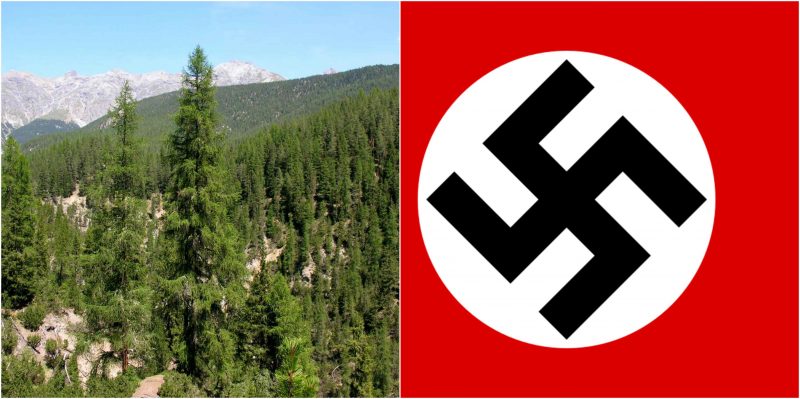This ancient symbol of prosperity was first used at least 11,000 years ago in Neolithic Eurasia and it has also been found in several religions such as Buddhism, Odinism, Hinduism, and Jainism.
Often seen engraved on houses in India or temples in Indonesia, the swastika derived its name from a Sanskrit term which means a lucky or auspicious object.
The symbol was present in Europe in the pre-Christian era and was found in Ancient Greece, in Roman catacombs, Serbia and Bosnia, Ukraine, the Nordic countries and on Celtic artifacts. The swastika became popular in the Western world when brands like Coca-Cola and Carlsberg started using it.
Even the US Army used the symbol during World War I. With the onset of the 1940’s and the increasing power of the Nazis, the true meaning of the treasured symbol was completely lost.
The ‘Forest swastika’ was planted in 1938 and remained hidden until 1992! pic.twitter.com/GAROkoqjie
— AtomicFact (@Atomicfact) November 21, 2015
The swastika was brought to Germany by the famous archaeologist Heinrich Schliemann, the discoverer of Troy, the 4000 years old city, in 1870. Although he was only an excavator on the site, Schliemann took the sole credit for the discovery.
Believing that Homer’s stories were not just myths, he searched for Troy for several years and became famous right after the discovery. While excavating through the remains of Troy, Schliemann noticed the swastika symbol all over the ancient city.
After Troy, the archaeologist continued his work around the world, from Asia and Africa to South America, and everywhere he went, in some part of that place, he found the swastika there. As his findings grew more popular, so did the symbol’s popularity in Western culture.
The ill fate of the symbol began when pre-Hitler nationalist groups in Germany adopted the swastika as a symbol of the felt superiority of their race. As racism in Germany grew, Hitler finally adopted the symbol as an insignia for the Nazi party in 1920.
In 1933, the Nazis went as far as forbidding the usage of the symbol for commercial reasons. The rest is history. During the war, the hooked cross was applied everywhere by the powerful Nazi propaganda machinery.
From pamphlets and flags to helmets and uniforms, the hooked cross was used everywhere, but the weirdest appearance of the swastika is definitely the one in a forest, made using trees.
The forest swastika was discovered in 1992 in Germany by Günter Reschke. Reschke was employed as an intern for a landscaping company at the time, and while doing aerial photos from a plane, he noticed the huge swastika on the northside of the city of Zernikow.
Made out of 100 larch trees in the middle of a thick pine forest, the patch of carefully planted trees covered an area of 4300 square yards.
The trees were precisely planted and arranged so they would form a huge swastika, and for more than 20 years, the trees would bloom in autumn, creating a contrast with the surrounding pines.
The effect would disappear in spring, thus leaving the symbol undiscovered for a long time. It is not certain who planted the trees and when they were planted, although forest specialist Klaus Göricke measured them and determined they were planted in the late 1930’s, or more precisely in 1938, just when Hilter’s power was growing.
There are several theories about the creators of the forest swastika, but none of them are as of yet verified. The first says that the trees were planted to honor Hitler’s birthday and ordered by a local Nazi officer.
The German newspaper Berliner Zeitung said that the trees were planted as a gesture of gratitude to the Reich Labor Service for building a street in Zernikow.
The third theory claims the symbol was made as a sign of loyalty after a villager from the area was sent to a concentration camp as punishment for secretly listening to the BBC radio.
Finally, a local man who said he was a member of The Hitler Youth Movement, claimed that they were the ones responsible for planting the trees. The Russians reported they knew about the existence of the forest swastika before 1992, although there is no proof of this.
The mysterious pine forest swastika http://t.co/3HKbxJYWAn pic.twitter.com/dsYks0N45h
— Lazer Horse (@Timboynewtron) December 22, 2014
There was an attempt to destroy the forest swastika by the German authorities in 1995. Concerned that the place would attract Nazi supporters, they removed 43 larch trees and 57 remained. This attempt was unsuccessful and the symbol is still noticeable from the air.
After a few tabloids published photos of the still existing symbol, the authorities removed an additional 25 trees and the forest swastika was finally destroyed.
Similar incidents occurred in the United States when the US Army discovered a tree made swastika in the late 1970’s. The same symbol appeared in a forest in Kyrgyzstan, discovered in 2006. The former symbol of love and prosperity is today banned in most of the countries around the globe.
Attempts were made to bring back the former glory and respect towards the swastika by various groups, but the true meaning of symbol still bears the consequences of Hitler’s acts of atrocity.
